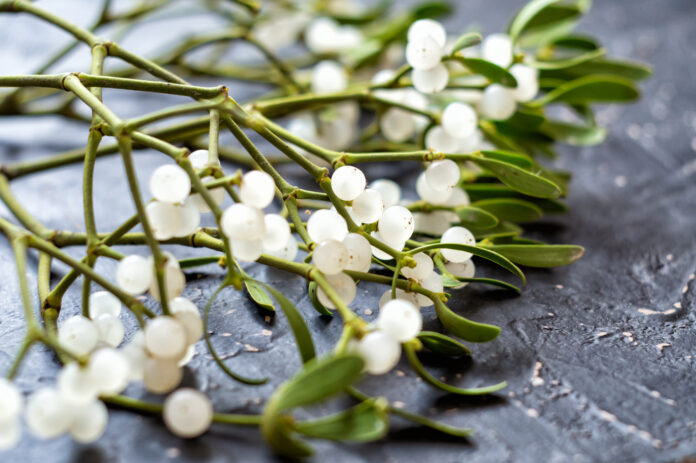Mistletoe is known for its presence during the holiday season. During dinner parties, couples will smooch under the festive plant with waxy leaves and sticky berries. At one point, mistletoe was also thought to hold mystical powers because it appeared to grow from nothing and had parasitic behaviors.
But mistletoe does more than seal a kiss. The berries off the festive plant can make a gluey thread called viscin. A study published in PNAS Nexus found that the threads of viscin from white-berry mistletoe could be made into flexible fibers that can stick to skin, cartilage, and other synthetic materials. The finding opens the possibilities for using the plant as a natural band-aid (wound sealant) and for other uses.
How Do We Know Mistletoe Is an Adhesive?
Scientists started investigating the berry’s tacky material after one of the study researchers observed their daughter playing with mistletoe.
“So, when my daughter was playing with a berry from a mistletoe we bought from a local Christmas market, and it started sticking to everything, I was intrigued,” said Matthew Harrington, senior author of the study and chemical biologist at McGill University, in a press release.
Read More: We May Kiss Under the Mistletoe, but Are These Berries Poisonous?
How Do Mistletoe Berries Stick to Surfaces?
(Credit:Brum/Shutterstock)
Mistletoe’s scientific name, Phoradendron, means “thief of the tree” because they are parasitic. Mistletoe grows on host trees after they send their roots into the bark and mooch off the trees’ resources like water and nutrients. But there is no need.
Mistletoe can photosynthesize for themselves. They prefer to be freeloaders. For this reason, they are not true parasites. Instead, experts consider mistletoe as hemiparasitic.
(Credit:PACO COMO/Shutterstock)
Mistletoe seeds begin their leeching ways by sticking onto the host plant and absorb moisture using the viscin that coats the seed. The berries can hitchhike to new host trees by a bird’s beak, an animal’s fur, or feathers. Seeds can also travel through an explosion: Ripe berries can burst, sending their seeds as far as 50 feet away.
Read More: How Ancient Holiday Traditions Have Changed Over Time
What Can We Use Mistletoe For?
The sticky substance that covers the seed helps it stick to its carriers and eventually a host. Knowing this, researchers studied how the viscin fibers could be stretched or shaped into 3D structures and stick to various surfaces.
Nils Horbelt, a recently graduated Ph.D. student at the Max Planck Institute, showed how resilient but easy it is to remove the mistletoe glue by wearing a thin coat of the glue on his fingers for days. According to a press release, Horbelt removed the glue after he rubbed his fingers together. The natural glue can stick on glass, plastic, and metal.
While researchers observed the stickiness of the mistletoe seeds, more questions remain about the gluey material. The team plans to investigate the mistletoe glue’s chemistry to replicate further and understand how the viscin can bond to surfaces.
Read More: 6 Fascinating Facts About Santa’s Sleigh Team
Source : Discovermagazine






